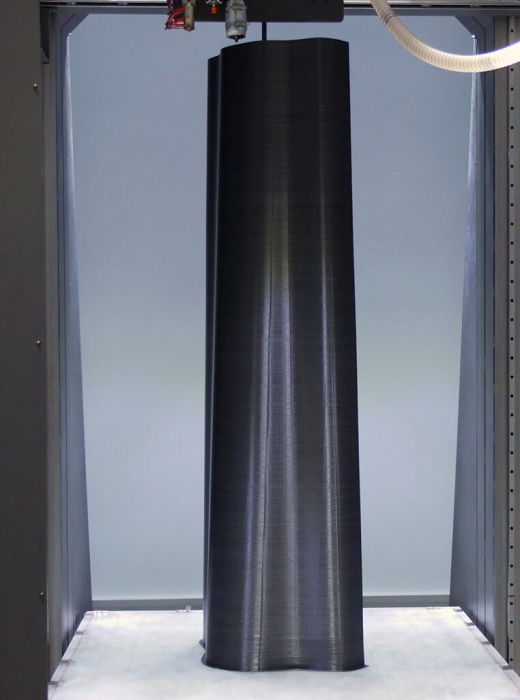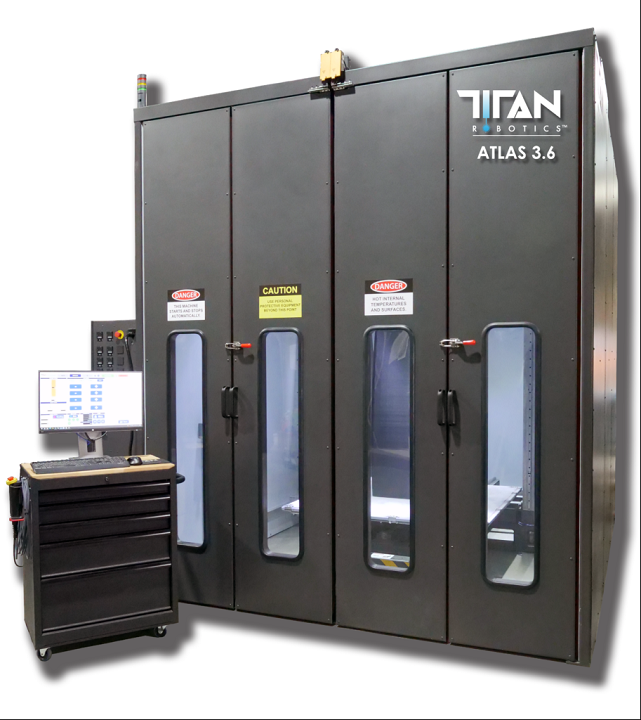Formnext Connect: Titan Robotics Releases Large-Format Atlas 3.6 3D Printer with Dual Pellet Extrusion
At Formnext Connect, Colorado company Titan Robotics, Ltd., which designs and develops large, production-scale AM solutions, has introduced its newest and largest 3D printer. The heavy-duty Atlas 3.6, with a build height of six feet, features a strong, rigid design, with powerful components, in order to provide accuracy, rapid 3D print speed, and handle the extra size and weight that comes with an increased size.
“When several of Titan’s industrial customers began requesting larger custom Atlas machines to meet their production needs, Titan began innovating to provide a robust solution to meet that need. With our team of engineers, manufacturing experts and our extensive experience in providing production additive manufacturing solutions, the development of the Atlas 3.6 further enables printing large parts at lower cost reliably using large-format industrial 3D printing,” Titan Robotics Partner, Rahul Kasat, said in a press release. “With this large build size, customers can now print large parts as is without worrying about slicing it in multiple sections for printing and trying to assemble it post-printing.”
Here’s what you need to know about the newest addition to Titan’s industrial Atlas line: it includes an actively heated chamber that can reach 80°C, so users can print with high-performance materials, such as ABS, CF-PEI, GF-PEKK, and Nylon, and increased print speeds of up to 30,000 mm per minute. According to the company, its 50″ x 50″ x 72″ build volume makes the Atlas 3.6 one of the market’s largest production 3D printers with pellet extrusion technology.
In addition to high flow filament 3D printing, Titan also specializes in direct pellet-fed extrusion, which helps to increase throughput with higher cycle times, as well as make it possible to print with a wider variety of materials, using hundreds of different formulations and resin grades, including highly filled engineering materials, like carbon fiber, and flexible, low durometer ones. Feedstock for pellet 3D printing on the Titan Atlas systems can reduce costs by ten times when compared with conventional AM filaments, which in turn helps to lower operational costs. With Titan’s pellet extrusion, users can print large production parts at flow rates of 1 to 30 pounds an hour, majorly increasing print time.
“As an innovative solutions provider, Titan Robotics was one of the first 3D printer manufacturers to commercialize pellet extrusion 3D printing,” the company states on its website. “Titan began developing direct pellet fed 3D printing on its Atlas systems in 2016 with commercialization of the technology a year later in 2017.”
The new Atlas 3.6 is only the latest in Titan’s line of industrial 3D printers featuring its Single Pellet Extrusion, Dual Pellet Extrusion, Hybrid Single Pellet + Filament Extrusion, and Hybrid Dual Pellet + Filament Extrusion configuration options. This gives users plenty of flexibility in their preferred extrusion technique. Pellet extrusion for high-deposition rates can enable fast printing of large parts, while filament extrusion is best for achieving fine details and high surface resolution, and a hybrid choice makes it possible to print with dual materials. Using these various extrusion configurations, industrial customers in a variety of industries, such as foundry, consumer appliances, and aerospace and defense, can use the Atlas 3.6 to create components for many applications, including functional parts, large-format tooling, patterns and molds, and end-use parts.
Other features of the Atlas 3.6 system include door safety interlocks systems, an industrial CNC motion control system with closed loop servos on all axes, sensor integrations like thermal imaging cameras, and material drying system integrations. It has a heated bed, a touchscreen user interface, rapid travel speeds up to 1M per minute, remote access and monitoring, and Simplify3D slicing software.
You can now purchase the new industrial Atlas 3.6 for large-format 3D printing, with the extrusion configurations. Contact Titan Robotics if you’d like the specs sheet for the printer.
(Source/Images: Titan Robotics)
Subscribe to Our Email Newsletter
Stay up-to-date on all the latest news from the 3D printing industry and receive information and offers from third party vendors.
Print Services
You May Also Like
Low-cost “Suzy” Polymer Powder 3D Printer is Faster and Cheaper than Past Models
Polish laser powder bed fusion (LPBF) firm Sinterit has released a follow-up to its predecessors, Lisa and Nils, called Suzy, a $19,490 printer equipped with a 30W fiber diode laser....
Japanese Advanced Manufacturing Capabilities Grow in Europe with Sodick’s Purchase of Prima Additive
The global economy is currently undergoing a reshuffling in terms of what gets manufactured where. In large part, this trend is being driven by new geopolitical alliances and the need...
Bosch Invests €6M into Serial Auto Part 3D Printing
German industrial conglomerate Robert Bosch GmbH, the world’s largest supplier of automotive parts, has announced a new investment into Nuremberg, Germany additive manufacturing (AM) facility. The nearly €6 million in...
3D Printing by the Numbers: Free AM Research Webinar to Dig into Market’s 2024 and 2025 Financial Performance
The additive manufacturing (AM) sector is at a pivotal moment, with industry growth stabilizing after a year of uneven performance. To help businesses and professionals navigate the evolving market, Additive...






























